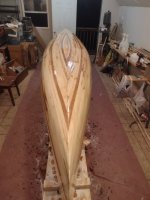I'd promised a pic of the scraped loose threads on the stern and I had a hard time getting one where you could even see them.
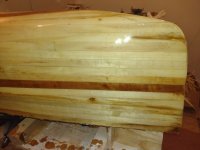
They're a little more visible in person but I'm extremely pleased with how well they cleaned up.
2 things that I'd forgotten to mention: While sanding for the last round of epoxy, I'd found 2 places where I'd left an air pocket under the glass (one where I'd wrapped the glass at the bow and 1 where the strips were particularly uneven on the chine).
I still had a clean syringe from gluing as I'd found that I could reuse the same one by running a small drill bit through the tip. While the wood glue had been too thick to suck up through the needle, the epoxy was not and I used an 18 gauge hypodermic needle to inject the epoxy under the glass & fill the cavity. Now that it's cured, it seems to have worked well and both places are solid. (I'd neglected to take "before" pics and "after" is, happily, invisible.)
The other thing I'd forgotten was that I'd built 2 (approx. 20x26 inch) Aspen panels to use as bulkheads for float chambers & hide the mess I'll likely make glassing the inside of the stems. I built them on scraps from cutting the forms, rasped them, sanded lightly and epoxied them when I did the final coat on the boat.
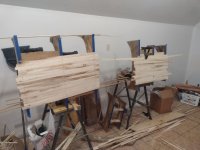
In hindsight, I should have laid the forms for these on the bench & epoxied them there but I didn't. I laid down paper to keep from permanently attaching the bulkheads to the plywood beneath and there were many places where the epoxy seeped through. As a result, the paper had to be scraped, rasped and sanded off the back of the bulkhead panels and I can hardly wait to get the hull off of the forms and see what a disaster is waiting for me inside my boat (yes, feel free to assume sarcasm... I'm rather fluent)
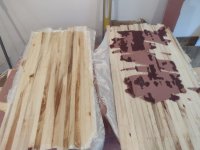
Getting the paper off was a PIA but 1) I am, again, pleased with how tough the epoxy is, 2) it's probably smoother than I'd have bothered to get it if not for the paper and 3) it really came out pretty well.
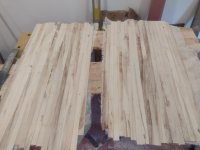
The plan is to cut them to fit inside the hull and epoxy them in place immediately after I coat the inside of the hull.
Next, I took a shot at laminating a seat. My reasoning was that, if lamination is truly stronger than a solid piece, I could bump up the color a bit by using strips of Aspen; kind of offsetting the poorer strength of the wood with the superior strength of the construction (I mentioned that I'm not an engineer, right?).
I used left over strips of Cherry & Aspen, made a form from a rough cut Hemlock 2x4, glued it together with wood glue & clamped it down. In the process, I clamped it to the railing by mistake and squeezed one of the clamps so hard that it broke. It was, however, broken in a way that it still held so I left the seat rail clamped to the outside railing overnight.

The drop on the front rail (shown) is 2 inches and I made another (not clamped to the exterior railing and using large c-clamps) for the rear with a 1 inch drop. Not sure yet which will make it to the final seat but, after the front rail dried, I placed it on 2 milk crates 32 inches apart (the seat rails are 36 as I'm hoping I can universally use them in all future builds) and I sat on it. My reasoning was that, if it held my weight as an individual rail, I could probably fall onto it from a standing position (always possible for me) and it would hold once integrated into a seat.
Sadly, It did not.
I was pleased with how the glue held as it ripped the wood strips apart along the grain but I should have paid more attention to how the grain was running through the strips and I'll also replace the Aspen with White Oak for the next test. My preference would be to only use 2 woods for each boat but I have the white oak, the weight penalty isn't a deal breaker IMO and, if I must pay a weight penalty, the seat may be the best place to invest. I'm headed over to the farm this afternoon to retrieve a white oak 1 x whatever I grab first and I'll make more rails tomorrow.
Oh, yeah, while the hull was still on the forms, I sanded it with 100 grit so it's roughed up for the spar varnish. 100 is probably a bit rough but (so am I sometimes and) it did pretty well removing runs and the few bugs that had gotten stuck while I glassed at night with the doors & windows open. I'll be starting the next build so that all of this can be done in the winter for sure. I'm itching to get it on the water but I did delay the big trip until the end of summer so I should have it done in time.
I plan to get it off the forms and see what catastrophe awaits inside later this week. After seeing the paper on the back of the bulkheads, I'm almost expecting epoxy stalactites in there.

![DSCN1383[1].JPG DSCN1383[1].JPG](https://www.canoetripping.net/data/attachments/26/26928-f200c863eb8be197b802fbe06ae8678d.jpg?hash=8gDIY-uL4Z)
![DSCN1384[1].JPG DSCN1384[1].JPG](https://www.canoetripping.net/data/attachments/26/26930-05c5130b0c83efc947873ca0050c1b9a.jpg?hash=BcUTCwyD78)
![DSCN1389[1].JPG DSCN1389[1].JPG](https://www.canoetripping.net/data/attachments/26/26931-dcd5d128b7a80edf50ef2142021f5046.jpg?hash=3NXRKLeoDt)
![DSCN1388[1].JPG DSCN1388[1].JPG](https://www.canoetripping.net/data/attachments/26/26932-a1cc157f84fbba30600c18c97e9cab50.jpg?hash=ocwVf4T7uj)
